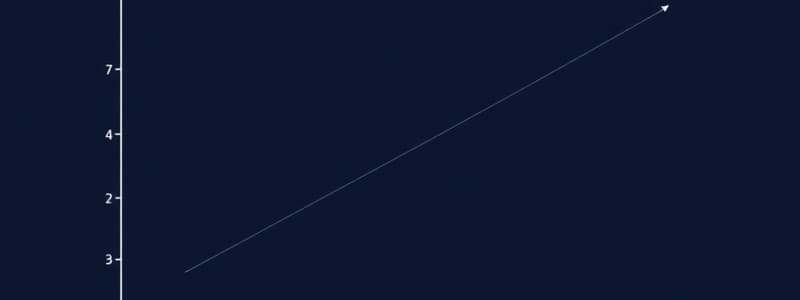Podcast
Questions and Answers
Which hormone is secreted by the thymus?
Which hormone is secreted by the thymus?
- Thymosin (correct)
- Gastrin
- Secretin
- Glucocorticoids
Where is the thymus located?
Where is the thymus located?
- Lower abdomen
- Upper thorax, below the throat (correct)
- In the brain
- Near the kidneys
What stimulates the secretion of gastric juice?
What stimulates the secretion of gastric juice?
- Secretin
- Gastrin (correct)
- Enterogastrone
- Cholecystokinin
Which part of the body produces secretin?
Which part of the body produces secretin?
What does cholecystokinin stimulate the release of?
What does cholecystokinin stimulate the release of?
What does Enterogastrone inhibit the secretion of?
What does Enterogastrone inhibit the secretion of?
Adrenal glands are located above which organs?
Adrenal glands are located above which organs?
Which of the following is produced by the adrenal cortex?
Which of the following is produced by the adrenal cortex?
What is a function of glucocorticoids?
What is a function of glucocorticoids?
Where are thyroid hormones produced?
Where are thyroid hormones produced?
What is the abbreviation for Thyroid-Stimulating Hormone?
What is the abbreviation for Thyroid-Stimulating Hormone?
What is the function of thyroxine?
What is the function of thyroxine?
Where are the parathyroid glands located?
Where are the parathyroid glands located?
What hormone do the parathyroid glands produce?
What hormone do the parathyroid glands produce?
What is the main function of parathormone?
What is the main function of parathormone?
Which of the following has two endocrine locations?
Which of the following has two endocrine locations?
What is stimulated by thymosin?
What is stimulated by thymosin?
Which hormone is controlled by Thyrotropin-Releasing Hormone (TRH)?
Which hormone is controlled by Thyrotropin-Releasing Hormone (TRH)?
Where is thyroxine stored?
Where is thyroxine stored?
What is the meaning of the prefix 'para' in parathyroids?
What is the meaning of the prefix 'para' in parathyroids?
Flashcards
Thymus
Thymus
Located in the upper thorax, below throat; most prominent at puberty, then disappears.
Thymosin
Thymosin
Stimulates immunologic competence in lymphoid tissues.
Stomach
Stomach
Has two endocrine locations: pyloric and duodenum mucosa.
Gastrin
Gastrin
Signup and view all the flashcards
Duodenum Mucosa
Duodenum Mucosa
Signup and view all the flashcards
Secretin/Cholecystokinin
Secretin/Cholecystokinin
Signup and view all the flashcards
Adrenals
Adrenals
Signup and view all the flashcards
Adrenal Cortex
Adrenal Cortex
Signup and view all the flashcards
Glucocorticoids
Glucocorticoids
Signup and view all the flashcards
Thyroid
Thyroid
Signup and view all the flashcards
Thyroid and Thyroid Releasing Hormones
Thyroid and Thyroid Releasing Hormones
Signup and view all the flashcards
Thyroxine
Thyroxine
Signup and view all the flashcards
Parathyroids
Parathyroids
Signup and view all the flashcards
Parathormone
Parathormone
Signup and view all the flashcards
Study Notes
- Algorithmic complexity measures resources needed to solve a problem of a certain size.
Time Complexity
- Time complexity quantifies the time an algorithm requires for a problem of a specific size.
- Big O notation expresses time complexity, indicating the upper limit of the algorithm's runtime growth as input increases.
- Examples of time complexities:
- $O(1)$: Constant time
- $O(log n)$: Logarithmic time
- $O(n)$: Linear time
- $O(n log n)$: Linearithmic time
- $O(n^2)$: Quadratic time
- $O(2^n)$: Exponential time
- $O(n!)$: Factorial time
Space Complexity
- Space complexity assesses memory an algorithm needs for a problem of a given size.
- Big O notation is used to denote space complexity, defining the upper growth limit of an algorithm's memory usage as the input grows.
Example Algorithm Analysis
- Consider a sorting algorithm:
for i from 1 to n:
for j from i+1 to n:
if arr[i] > arr[j]:
swap arr[i] and arr[j]
- Time Complexity: The nested loops result in $n(n-1)/2$ iterations, making it $O(n^2)$.
- Space Complexity: The algorithm uses a constant amount of extra memory, resulting in $O(1)$ space complexity.
Common Time Complexities
| Complexity | Name | Example |
|---|---|---|
| $O(1)$ | Constant | Accessing an element in an array |
| $O(log n)$ | Logarithmic | Binary search |
| $O(n)$ | Linear | Searching for an element in a list |
| $O(n log n)$ | Linearithmic | Merge sort |
| $O(n^2)$ | Quadratic | Bubble sort |
| $O(2^n)$ | Exponential | Finding all subsets of a set |
| $O(n!)$ | Factorial | Finding all permutations of a set |
Diagram of Time Complexities
- A log-log plot visualizes time complexity versus input size $n$.
- The x-axis represents Input Size ($n$) from 1 to 100.
- The y-axis represents Time Complexity from 1 to $10^8$.
- The graph illustrates several time complexities:
- Constant ($O(1)$): Displayed as a horizontal line at Time Complexity = 1.
- Logarithmic ($O(log n)$): Increases slowly as $n$ increases.
- Linear ($O(n)$): Shown as a straight line with a slope of 1.
- n Log n ($O(n log n)$): Increases faster than linear.
- Quadratic ($O(n^2)$): Increases much faster than linear.
- Exponential ($O(2^n)$): Increases extremely rapidly.
Studying That Suits You
Use AI to generate personalized quizzes and flashcards to suit your learning preferences.



